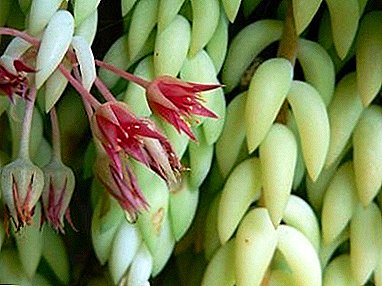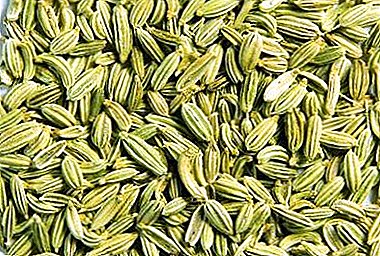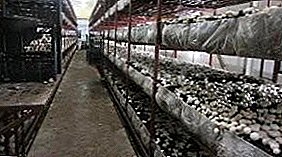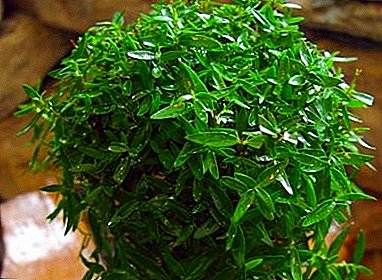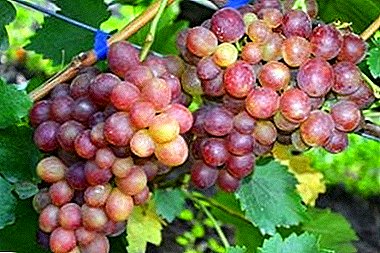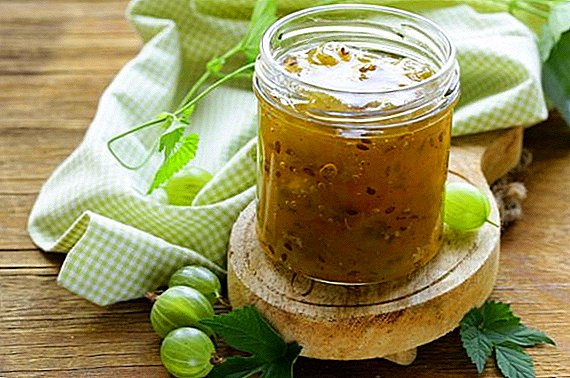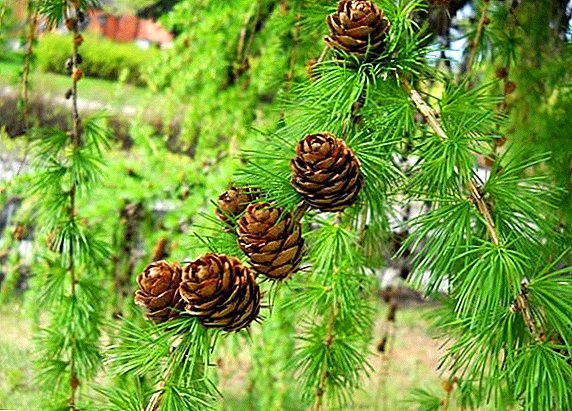 Larch is one of the most common coniferous tree species. Belongs to the family of pine.
Larch is one of the most common coniferous tree species. Belongs to the family of pine.
The plant is often found in forests, mountains, park areas. In addition, it can be a wonderful part of the decor of your garden. This breed is valued not only for its beauty, but also for durable, resistant to rotting wood. In total there are about twenty plant species, the article describes the most basic species and varieties of larch.
Tamarack
American larch in nature is most common in Canada and northeastern regions of America. The tree reaches a height of 12 to 30 m, the trunk diameter varies within 50 cm. It has a dense cone-shaped crown with long curved branches.
The bark of young representatives has an orange or dark yellow shade, in adult plants - brown with a red tint. The needles of larch in length reach from 1 to 3 cm. The plants of this species have the smallest cones. In size they reach only 2 cm, but they have an unusually beautiful shape, like rose flowers. In cones there is only 4 seeds.
Did you know? The needles of all species of larches in the autumn turn yellow and fall off. It is thanks to this feature that the plant received such a name.The tree loves well-lit places, the fertility of the soil is not demanding. It grows even on the poorest soils in the permafrost regions. However, the most favorable for development are friable loamy and sandy places. When growing in a garden, you need to pay attention to the irrigation regime: a young tree is watered quite often, and an adult - only during periods of drought. Propagated by seeds, which are formed in the cones. However, they rise very slowly.
Important! This view is not suitable for curly trimming. Allowed to remove only small knots in the autumn.
Archangel larch
The height reaches 40 m, with a diameter of about 150 cm. It is very similar to the Siberian larch, but it has some differences. Some of them are:
- thickening of the trunk to the base;
- light yellow, slightly raised branches;
- larger seeds.

Did you know? Arkhangelsk larch belongs to the most valuable species. Its wood is very strong, durable, contains a large amount of resin and is extremely resistant to rotting.
Larch Gmelin (Daurian)
This species of larch is known for its extraordinary resistance to frost, adverse weather conditions and poor soils. It grows in areas of permafrost, on mountain rocky slopes, marshy and peaty places.  It reaches a maximum of 30 m in height, and 80 cm in width. It is distinguished by a thick bark with deep furrows. The crown is oval. The needles are collected in a bundle and densely scattered along the branches, mainly in a checkerboard pattern. The needles are narrow, long, has a beautiful light green tint in spring and bright green - in summer. Cones, when blooming, are very similar to flowers of a rose. By the end of the summer, they acquire a charming purple color. Fruits of larch ripen in late summer - early autumn.
It reaches a maximum of 30 m in height, and 80 cm in width. It is distinguished by a thick bark with deep furrows. The crown is oval. The needles are collected in a bundle and densely scattered along the branches, mainly in a checkerboard pattern. The needles are narrow, long, has a beautiful light green tint in spring and bright green - in summer. Cones, when blooming, are very similar to flowers of a rose. By the end of the summer, they acquire a charming purple color. Fruits of larch ripen in late summer - early autumn.
This type is actively used for decorative purposes. Gmeline looks great in park areas and alleys. The disadvantages of such larch are low seed germination and slow growth.
European larch
Under natural conditions it grows in Western and Central Europe on the slopes of foothill zones. It grows in height from 25 to 40 m, in width - from 0.8 to 1.5 m. Sagging branches are an expressive feature of the species. The crown can be oval or irregular in shape. The young representatives of the bark gray, adults - brown.  The needles have a delicate light green color, reaching a length of 0.4 cm. On the branches are collected in bunches, which are densely scattered in a chaotic manner. Cones in trees of this species open weakly, have a rich brown color.
The needles have a delicate light green color, reaching a length of 0.4 cm. On the branches are collected in bunches, which are densely scattered in a chaotic manner. Cones in trees of this species open weakly, have a rich brown color.
Propagated by seeds that ripen in October. An empty cone can hang on a tree for about ten years. European larch is cold-resistant, grows well on mountain soils, does not like marshy soil. Today, many ornamental varieties of European larch are bred. The most popular representatives include:
- "weeping" - looks like a willow, its branches are thin and their tips go downwards;
- “creeping” - it is distinguished by an unusual trunk, which practically lies on the ground and winds along it, the crown is represented by thin falling shoots;
- "compacta" - it is distinguished by its low growth, dense squat crown with thin shoots;
- "Korlei" - has a round shape, does not possess a central shoot.
Important! European larch has an increased ability to purify the air. Therefore, such a tree is especially recommended to grow in polluted, dusty regions.
Western larch
 In height, the plant reaches from 30 to 80 m, in diameter from 0, 9 to 2, 4 m. It differs from the previous species by short shoots and a crown in the shape of a pyramid. The bark of this species has a brown tinge with a grayish tint and deep furrows. The needles are light green, from 0.2 to 0.4 cm long, gathered in bunches and densely planted on the shoots. In mid-October, the needles turn yellow and fall off, and in May a new one will grow in its place.
In height, the plant reaches from 30 to 80 m, in diameter from 0, 9 to 2, 4 m. It differs from the previous species by short shoots and a crown in the shape of a pyramid. The bark of this species has a brown tinge with a grayish tint and deep furrows. The needles are light green, from 0.2 to 0.4 cm long, gathered in bunches and densely planted on the shoots. In mid-October, the needles turn yellow and fall off, and in May a new one will grow in its place.
Cones are long, red-brown, open badly. By such biological features, they differ significantly from the previously considered species. After opening, the cones often remain on the tree, acquiring a grayish tint. Seeds of western larch germinate well and quickly.
Larch loves well-lit areas with loose, fertile soil. Decorative forms of the plant should be regularly cut. It prefers moist soil, therefore it needs watering during periods of drought.
Larch cajander
The characteristic of Kayander larch is very similar to the description of Gmelin. They especially look like cones, which are represented by five or six scaly rows and have a charming dark red color, which is very similar to roses. Old buds change color to light brown. The length reaches 0.3 cm. However, Cajander has cones narrower than Gmelin.  In height it grows up to 25 m, in width - up to 0.7 m. The bark of young trees is gray, in adults it is dark brown with a red tint, densely strewn with longitudinal cracks. Needles reach a length of 6 cm, collected in bundles of 10-60 needles.
In height it grows up to 25 m, in width - up to 0.7 m. The bark of young trees is gray, in adults it is dark brown with a red tint, densely strewn with longitudinal cracks. Needles reach a length of 6 cm, collected in bundles of 10-60 needles.
Did you know? It is amazing how many years the Kayander larch grows. The tree lives about 800 years, and in favorable conditions it can live to 900.This species is winter-resistant, grows well even on infertile, cold soils. Propagated by seeds. In warm conditions, the seeds ripen and germinate quickly enough.
Larch Kamchatka (Kuril)
In natural conditions it grows on the Kuril, Shantar Islands, Sakhalin. It reaches 35 m in height, 0.4 m in diameter. The crown is irregular, closer to the oval shape. It differs from other species by long horizontal branches. Cones are oval, in length reach 2 cm, in width - 1, 5 cm. 
Primorye larch
Is a hybrid. She was bred by crossing Kamchatka larch with Gmelin. It is 25 meters tall, 0.6 meters wide. The branches are grayish in color with sparse hairs. The needles are dark green in color, slightly bluish on the tips, reach 3.5 cm in length. Oval-shaped cones, grow up to 3 cm in length. During maturation, the scales of the cones open 40-50 degrees. Brown seeds with a red tint.
Siberian larch
Under natural conditions, it grows in coniferous forests of Siberia, in the Urals, and Altai. In deciduous forests is rare. He loves podzolic, moist soil and a lot of sunlight.
The height reaches 40 m, the diameter of the trunk varies from 10 to 180 cm. The crown is rare, oval. The bark has a grayish tint and deep longitudinal grooves. On young plants, it is light yellow and smooth. The needles are narrow, 4.5 cm long, flat, light green in color. On the branches of the needles are collected in bunches of 25-40 pieces. 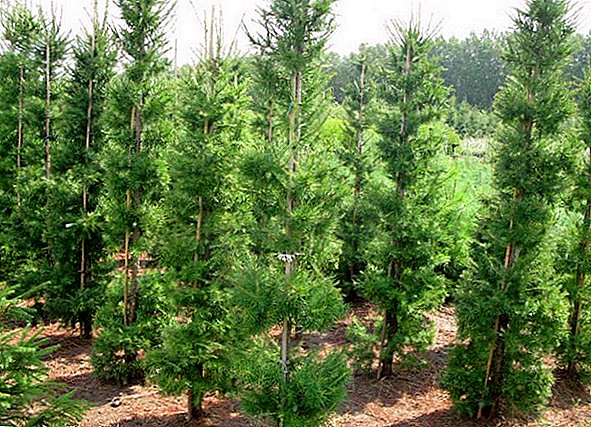 Cones of Siberian larch are oval, up to 4 cm long, up to 3 cm wide. They are formed from 20-40 scales, which are located in 5-7 rows. Young cones are brown, old - light yellow color. Empty cones hang on the branches for about 4 years, then they fall off. Larch seeds are small, yellow.
Cones of Siberian larch are oval, up to 4 cm long, up to 3 cm wide. They are formed from 20-40 scales, which are located in 5-7 rows. Young cones are brown, old - light yellow color. Empty cones hang on the branches for about 4 years, then they fall off. Larch seeds are small, yellow.
Important! The needles and pitch of the Siberian larch possess powerful hemostatic and anti-inflammatory properties.Siberian larch has two types of branches:
- long annuals with single-spaced needles;
- short perennial, on which the needles are collected in bunches.
Did you know? Siberian larch wood surpasses all other conifers in technical characteristics. It is widely used in shipbuilding, as it is perfectly stored in water and is very resistant to rotting. However, the freshly chopped wood will sink into the water.
Japanese Larch (Kempfer)
 In natural conditions it lives in the vastness of the Japanese island of Honshu. If you wanted to know which larch grows as quickly as possible, then such is the Kempfer larch. It reaches a height of up to 35 m. It has long, thick, horizontal branches. The crown is represented in the shape of a pyramid. The bark of the tree trunk is thin, red-brown, and the branches are grayish.
In natural conditions it lives in the vastness of the Japanese island of Honshu. If you wanted to know which larch grows as quickly as possible, then such is the Kempfer larch. It reaches a height of up to 35 m. It has long, thick, horizontal branches. The crown is represented in the shape of a pyramid. The bark of the tree trunk is thin, red-brown, and the branches are grayish.
Japanese larch has a very beautiful long green-blue needles, which can be up to 5 cm in length. The cones are round, formed by thin brown scales. Propagated by small brown seeds. Empty buds may still hang on the tree for about 3 years.
A feature of this species is that its growth requires clay or loamy moist soil. Most widely used for decorative purposes.
Now you know about the most common larches and can easily distinguish them. You can grow any of the presented species in your garden. Before purchasing, be sure to consider the preferences of a particular type and the climatic, soil conditions on your plot.


